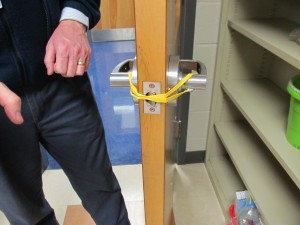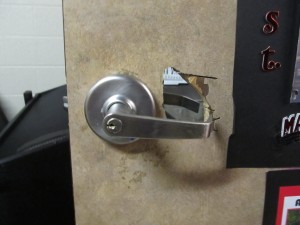
School officials sometimes use rubber bands, magnets and other devices to allow them to pre lock classroom doors to speed the process of lockdown
Three Steps to Faster School Lockdowns
School lockdowns remain a hot topic. Every time a mass casualty school shooting takes place interest in ways to improve school lockdowns increases. A small but vocal minority suggests we abandon the concept of lockdown completely. However, the many instances where school lockdowns have been successfully applied indicate that perhaps more emphasis on properly preparing school employees to implement school lockdowns is in order. I have noticed six common opportunities for more reliable school lockdown approaches.
1. Physically prepare staff to implement a school lockdown.
Michelle Gay lost her child in the Sandy Hook School shooting. Michelle related to me that her child’s substitute teacher had never been issued a key to the classroom making it impossible for her to lock the door. While many people have been advocating that this substitute should have been provided military style close quarters combat training to enable her to attack the killer, a more practical observation is that she lacked a key to lock her classroom door.
2. Properly train staff to implement a school lockdown.
Michelle also related to me that her child’s substitute teacher had never been issued a lockdown protocol, trained to perform a lockdown, nor participated in a lockdown drill. Though these concepts are very basic requirements for reliable school lockdowns, this is still not an uncommon situation even after the Sandy Hook tragedy.
3. Mentally prepare staff to implement a school lockdown without being told to do so.
Unfortunately, most schools still conduct “1958 style drills.” These drills are the same type of drills that allowed an elementary child to murder 95 staff and students by burning down the Our Lady of Angels Sacred Hearts School in Chicago in 1958. Though the school conducted nine fire drills each year, the principal always pulled the fire alarm during drills. This accidentally conditioned employees that someone else would pull the alarm. During the stress of the event, no teacher activated the fire alarm for an estimated five minutes after the fire was detected. Safe Havens has developed research-based drill approaches that require school staff to respond to scenarios to initiate each drill. This helps to mentally prepare staff to make the decision to implement protective actions rather than to wait to be directed to do so in an emergency.
These three opportunities for improvement are all very simple. At the same time, they are extremely important ways to improve survivability in the event an emergency lockdown becomes necessary. For more information on evidence-based school lockdown concepts, Safe Havens offers two free web courses at: http://safehavensinternational.org/school-safety-web-courses/

